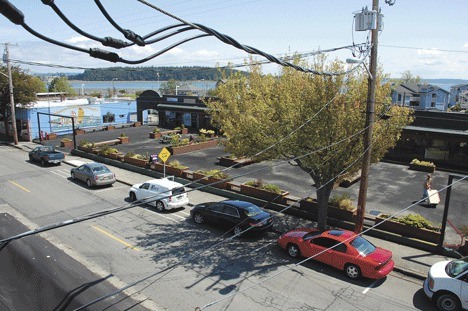The Oak Harbor City Council has agreed to spend up to $2 million from its own coffers to help pay for a portion of the controversial Pioneer Way Improvement Project that city officials had been hoping would be funded with local and state grant funds.
In May, the state Department of Commerce alerted the city that its request for a $1 million grant, which would have helped shoulder the $2 million cost of burying electrical and communication lines on Pioneer Way, had been rejected.
Addressing the council Tuesday, June 15, City Engineer Eric Johnston said the city is still planning on applying for an Island County Economic Development Fund grant but, like the state grant, there are no guarantees for success. He urged the council to prepare for a “worst case scenario” by agreeing to pay for the project with city funds.
The council approved the proposal in a 4-2 vote following more than one hour of discussion. Council members Rick Almberg, Jim Campbell, Beth Munns and Bob Severns voted for the motion while Scott Dudley and Jim Palmer voted against it. Mayor pro tem Danny Paggao did not vote as he was filling in for Mayor Jim Slowik, who was on vacation.
The decision is meeting with mixed public reaction. Several downtown business owners have applauded the move, saying that if the city is going to do the improvement project it needs to be done right by burying power lines.
“I don’t have a problem with underground; I think it should be done,” said Gloria Carothers, owner of the Jewelry Gallery on Pioneer Way.
Others, however, say that while the project will no doubt improve the aesthetics of the business district, that’s a lot of money to be spent on a single group of Oak Harbor businesses.
“If the downtown merchants believe underground utilities is that critical for their businesses, they should pay for it,” said Mel Vance, during the public comment period at Tuesday’s council meeting.
In November of 2009, the council approved the designation of $6.35 million in funds for the overall improvement project. Although officials were aware of and had planned to bury power lines underground, a funding source was not identified at the time due to the possibility of receiving grants funds.
Johnston acknowledged Tuesday that burying utilities was elective and that the council could move forward with the improvement project without taking that step.
However, if the council did want to proceed it would need to make a decision soon. Turning Pioneer into a one-way street will require some power-line work, whether they are put underground or above, and the work can only be done by Puget Sound Energy. The company needs a signed contract specifying the amount the city will pay and a timeline for completed work, Johnston said.
Council Rick Almberg questioned the contracts lack of specificity.
“We’re committing to this money without really knowing what their obligation is,” Almberg said.
But the majority of concerns were focused on the funding source city staff proposed. Unless grants come through, the $2 million will come out of the real estate excise tax fund, a special pot of money collected from sales tax generated within city limits. They are non-discretionary funds and can only be used to pay for projects outlined in the city’s capital improvements plan. A recent use of the fund was the re-roofing of the windmill in Windjammer Park.
In its decision this past November, the council did agree to put $3.5 million of the total $5.55 million in the fund toward the improvement project. If the additional $2 million is also used, it will leave the pot with a $94,441 balance.
According to City Finance Director Doug Merriman, the fund currently receives about $300,000 per year. At that rate, it would take up to seven years to replenish the $2 million and up to 18 years to replenish all $5.5 million, he said.
“That’s in the current environment,” Merriman said. “If things improved, it could be quicker than that.”
City Council member Jim Palmer said he voted for the improvement project in November and that he still agrees with his decision. However, he did not envision draining the city real estate excise tax fund to do it.
“I’m struggling with the idea of spending an additional $2 million and ending up with basically very little REET funds,” Palmer said.
Although the issue was discussed in depth, most council members agreed that the need for underground utility lines justified the expense.
Council member Beth Munns compared it to the initial construction and development of the Oak Harbor marina. Public officials at the time likely faced sharp public criticism over expense and need, said Munns, but in the end it was a very worth investment.
“Sometimes you have to be brave enough for the vision to benefit the citizens,” Munns said.



